Human-Fish Interactions: Exploring Roles, Impacts, and Future Trends
VerifiedAdded on 2022/09/17
|9
|2341
|20
Essay
AI Summary
This essay delves into the multifaceted relationship between humans and fish, examining both historical and modern interactions. It explores the evolution of human reliance on aquatic resources, from traditional fishing practices to industrial-scale operations. The paper analyzes the various roles fish play in human lives, including their significance as a food source, a source of income, and a recreational pursuit. It investigates the impact of human activities, particularly overfishing, on fish populations and marine ecosystems. The essay also discusses the socio-economic incentives and disincentives that influence human interactions with fish, considering the commodification of fish and its consequences. Finally, the essay speculates on how these associations and perceptions might change in the next 20 years, taking into account factors such as sustainability, technological advancements, and evolving consumer demands, providing a comprehensive overview of the human-fish dynamic.
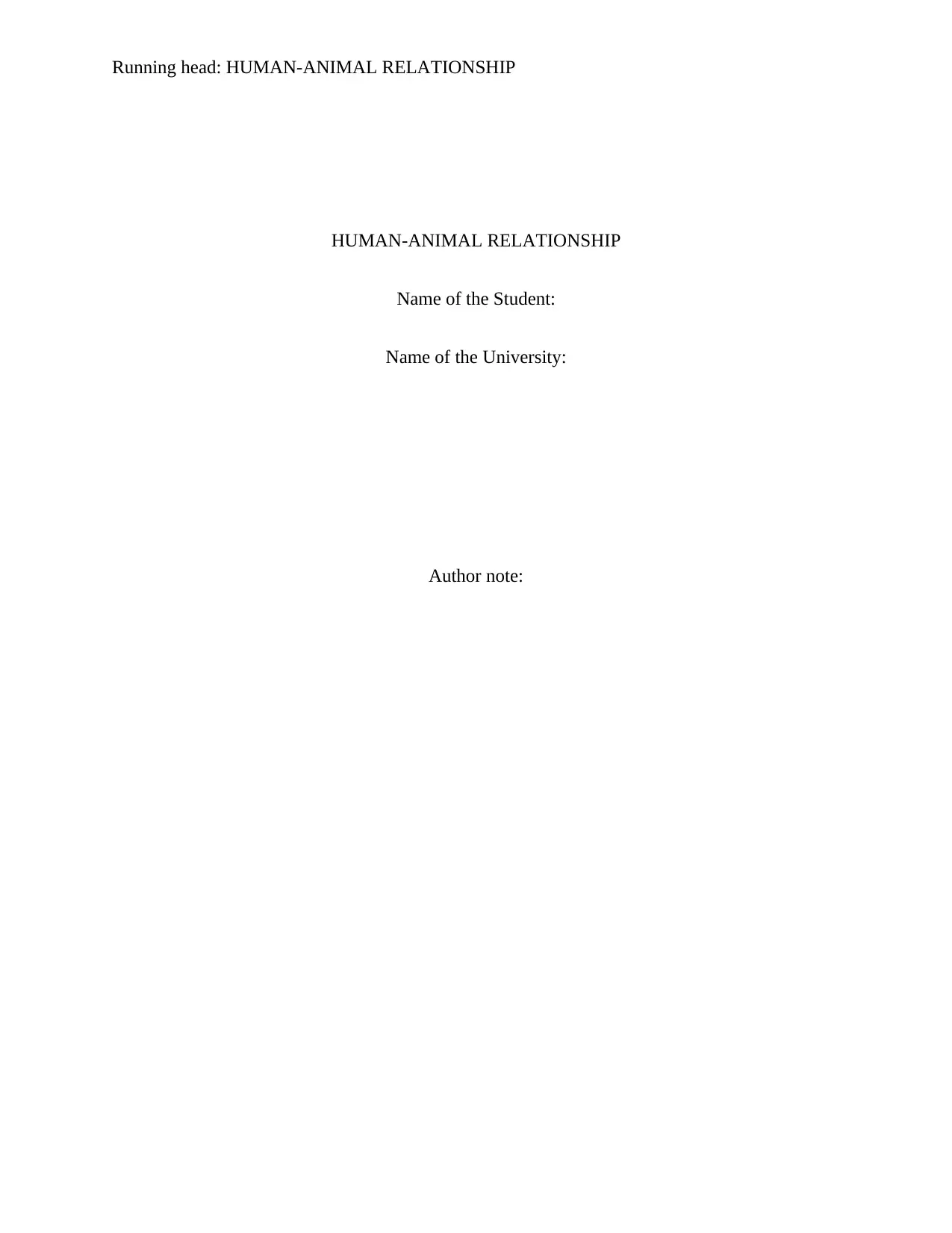
Running head: HUMAN-ANIMAL RELATIONSHIP
HUMAN-ANIMAL RELATIONSHIP
Name of the Student:
Name of the University:
Author note:
HUMAN-ANIMAL RELATIONSHIP
Name of the Student:
Name of the University:
Author note:
Paraphrase This Document
Need a fresh take? Get an instant paraphrase of this document with our AI Paraphraser
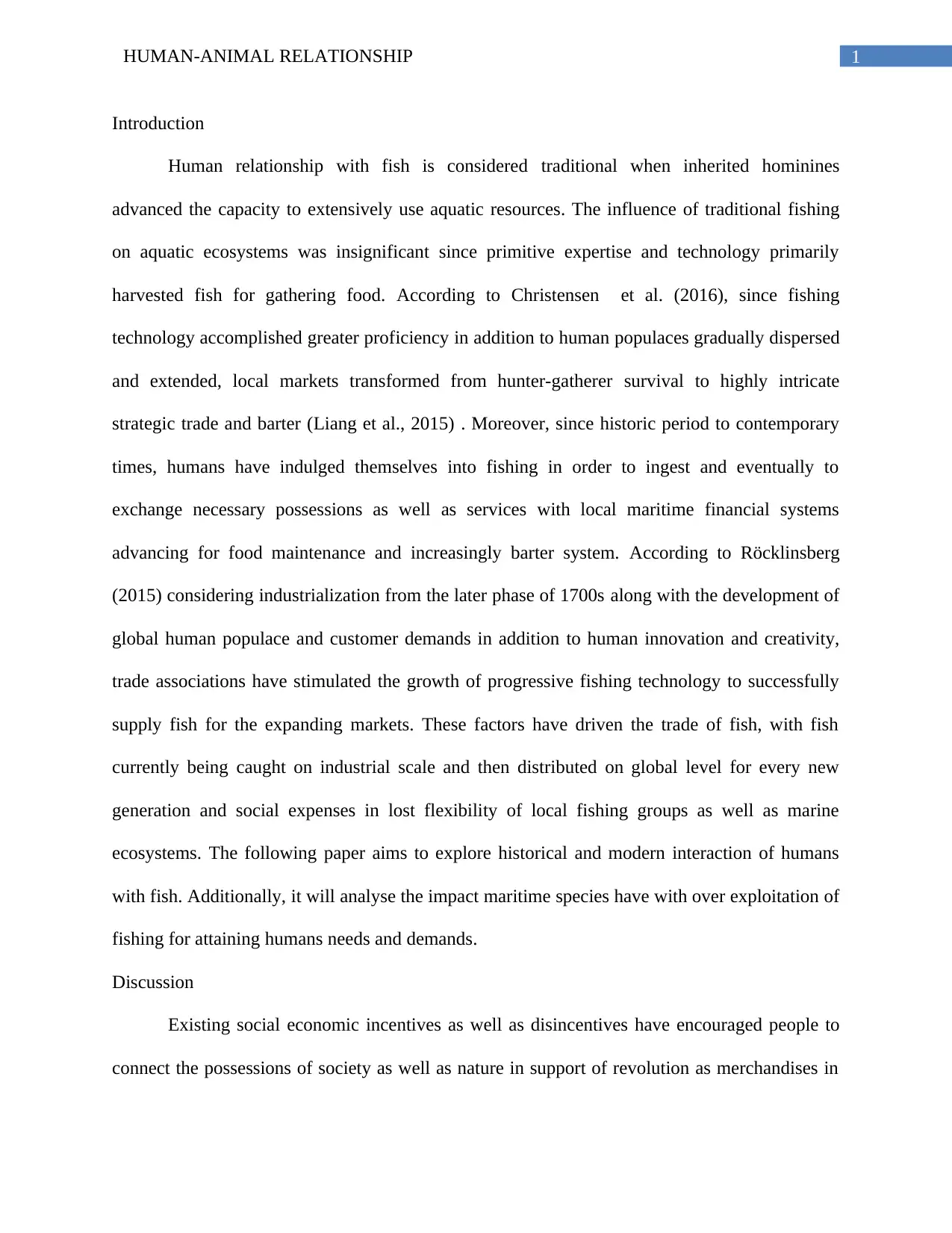
1HUMAN-ANIMAL RELATIONSHIP
Introduction
Human relationship with fish is considered traditional when inherited hominines
advanced the capacity to extensively use aquatic resources. The influence of traditional fishing
on aquatic ecosystems was insignificant since primitive expertise and technology primarily
harvested fish for gathering food. According to Christensen et al. (2016), since fishing
technology accomplished greater proficiency in addition to human populaces gradually dispersed
and extended, local markets transformed from hunter-gatherer survival to highly intricate
strategic trade and barter (Liang et al., 2015) . Moreover, since historic period to contemporary
times, humans have indulged themselves into fishing in order to ingest and eventually to
exchange necessary possessions as well as services with local maritime financial systems
advancing for food maintenance and increasingly barter system. According to Röcklinsberg
(2015) considering industrialization from the later phase of 1700s along with the development of
global human populace and customer demands in addition to human innovation and creativity,
trade associations have stimulated the growth of progressive fishing technology to successfully
supply fish for the expanding markets. These factors have driven the trade of fish, with fish
currently being caught on industrial scale and then distributed on global level for every new
generation and social expenses in lost flexibility of local fishing groups as well as marine
ecosystems. The following paper aims to explore historical and modern interaction of humans
with fish. Additionally, it will analyse the impact maritime species have with over exploitation of
fishing for attaining humans needs and demands.
Discussion
Existing social economic incentives as well as disincentives have encouraged people to
connect the possessions of society as well as nature in support of revolution as merchandises in
Introduction
Human relationship with fish is considered traditional when inherited hominines
advanced the capacity to extensively use aquatic resources. The influence of traditional fishing
on aquatic ecosystems was insignificant since primitive expertise and technology primarily
harvested fish for gathering food. According to Christensen et al. (2016), since fishing
technology accomplished greater proficiency in addition to human populaces gradually dispersed
and extended, local markets transformed from hunter-gatherer survival to highly intricate
strategic trade and barter (Liang et al., 2015) . Moreover, since historic period to contemporary
times, humans have indulged themselves into fishing in order to ingest and eventually to
exchange necessary possessions as well as services with local maritime financial systems
advancing for food maintenance and increasingly barter system. According to Röcklinsberg
(2015) considering industrialization from the later phase of 1700s along with the development of
global human populace and customer demands in addition to human innovation and creativity,
trade associations have stimulated the growth of progressive fishing technology to successfully
supply fish for the expanding markets. These factors have driven the trade of fish, with fish
currently being caught on industrial scale and then distributed on global level for every new
generation and social expenses in lost flexibility of local fishing groups as well as marine
ecosystems. The following paper aims to explore historical and modern interaction of humans
with fish. Additionally, it will analyse the impact maritime species have with over exploitation of
fishing for attaining humans needs and demands.
Discussion
Existing social economic incentives as well as disincentives have encouraged people to
connect the possessions of society as well as nature in support of revolution as merchandises in
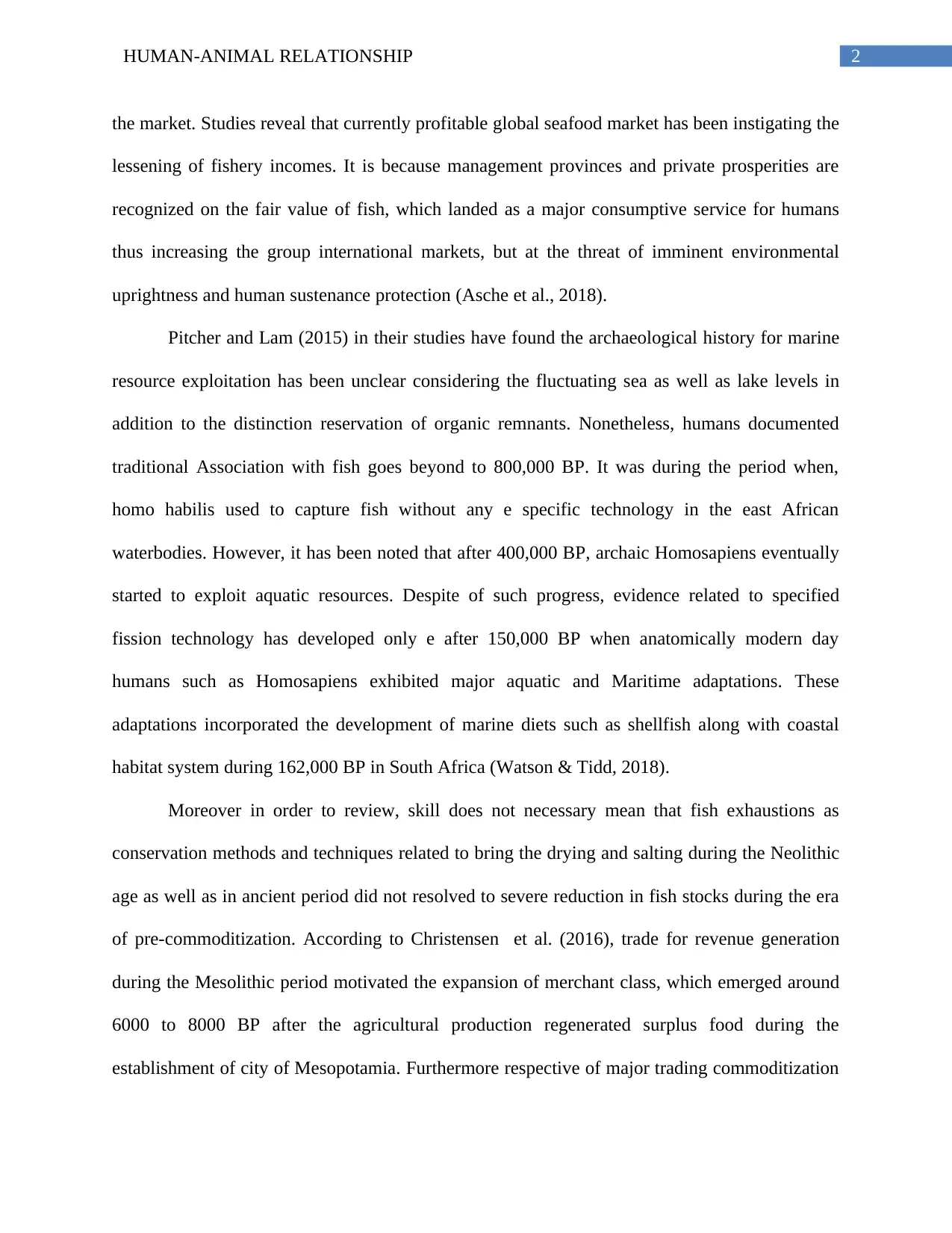
2HUMAN-ANIMAL RELATIONSHIP
the market. Studies reveal that currently profitable global seafood market has been instigating the
lessening of fishery incomes. It is because management provinces and private prosperities are
recognized on the fair value of fish, which landed as a major consumptive service for humans
thus increasing the group international markets, but at the threat of imminent environmental
uprightness and human sustenance protection (Asche et al., 2018).
Pitcher and Lam (2015) in their studies have found the archaeological history for marine
resource exploitation has been unclear considering the fluctuating sea as well as lake levels in
addition to the distinction reservation of organic remnants. Nonetheless, humans documented
traditional Association with fish goes beyond to 800,000 BP. It was during the period when,
homo habilis used to capture fish without any e specific technology in the east African
waterbodies. However, it has been noted that after 400,000 BP, archaic Homosapiens eventually
started to exploit aquatic resources. Despite of such progress, evidence related to specified
fission technology has developed only e after 150,000 BP when anatomically modern day
humans such as Homosapiens exhibited major aquatic and Maritime adaptations. These
adaptations incorporated the development of marine diets such as shellfish along with coastal
habitat system during 162,000 BP in South Africa (Watson & Tidd, 2018).
Moreover in order to review, skill does not necessary mean that fish exhaustions as
conservation methods and techniques related to bring the drying and salting during the Neolithic
age as well as in ancient period did not resolved to severe reduction in fish stocks during the era
of pre-commoditization. According to Christensen et al. (2016), trade for revenue generation
during the Mesolithic period motivated the expansion of merchant class, which emerged around
6000 to 8000 BP after the agricultural production regenerated surplus food during the
establishment of city of Mesopotamia. Furthermore respective of major trading commoditization
the market. Studies reveal that currently profitable global seafood market has been instigating the
lessening of fishery incomes. It is because management provinces and private prosperities are
recognized on the fair value of fish, which landed as a major consumptive service for humans
thus increasing the group international markets, but at the threat of imminent environmental
uprightness and human sustenance protection (Asche et al., 2018).
Pitcher and Lam (2015) in their studies have found the archaeological history for marine
resource exploitation has been unclear considering the fluctuating sea as well as lake levels in
addition to the distinction reservation of organic remnants. Nonetheless, humans documented
traditional Association with fish goes beyond to 800,000 BP. It was during the period when,
homo habilis used to capture fish without any e specific technology in the east African
waterbodies. However, it has been noted that after 400,000 BP, archaic Homosapiens eventually
started to exploit aquatic resources. Despite of such progress, evidence related to specified
fission technology has developed only e after 150,000 BP when anatomically modern day
humans such as Homosapiens exhibited major aquatic and Maritime adaptations. These
adaptations incorporated the development of marine diets such as shellfish along with coastal
habitat system during 162,000 BP in South Africa (Watson & Tidd, 2018).
Moreover in order to review, skill does not necessary mean that fish exhaustions as
conservation methods and techniques related to bring the drying and salting during the Neolithic
age as well as in ancient period did not resolved to severe reduction in fish stocks during the era
of pre-commoditization. According to Christensen et al. (2016), trade for revenue generation
during the Mesolithic period motivated the expansion of merchant class, which emerged around
6000 to 8000 BP after the agricultural production regenerated surplus food during the
establishment of city of Mesopotamia. Furthermore respective of major trading commoditization
⊘ This is a preview!⊘
Do you want full access?
Subscribe today to unlock all pages.

Trusted by 1+ million students worldwide
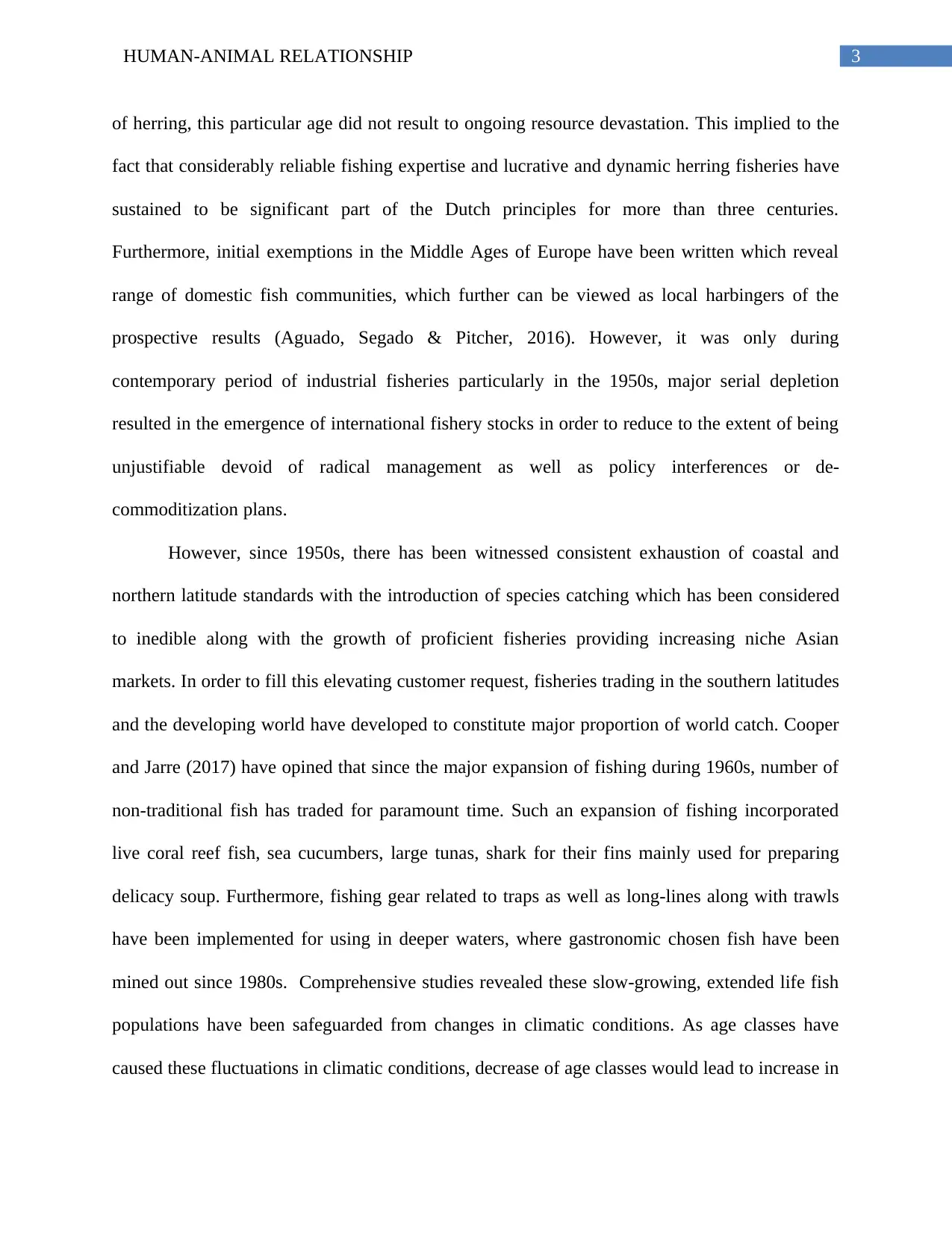
3HUMAN-ANIMAL RELATIONSHIP
of herring, this particular age did not result to ongoing resource devastation. This implied to the
fact that considerably reliable fishing expertise and lucrative and dynamic herring fisheries have
sustained to be significant part of the Dutch principles for more than three centuries.
Furthermore, initial exemptions in the Middle Ages of Europe have been written which reveal
range of domestic fish communities, which further can be viewed as local harbingers of the
prospective results (Aguado, Segado & Pitcher, 2016). However, it was only during
contemporary period of industrial fisheries particularly in the 1950s, major serial depletion
resulted in the emergence of international fishery stocks in order to reduce to the extent of being
unjustifiable devoid of radical management as well as policy interferences or de-
commoditization plans.
However, since 1950s, there has been witnessed consistent exhaustion of coastal and
northern latitude standards with the introduction of species catching which has been considered
to inedible along with the growth of proficient fisheries providing increasing niche Asian
markets. In order to fill this elevating customer request, fisheries trading in the southern latitudes
and the developing world have developed to constitute major proportion of world catch. Cooper
and Jarre (2017) have opined that since the major expansion of fishing during 1960s, number of
non-traditional fish has traded for paramount time. Such an expansion of fishing incorporated
live coral reef fish, sea cucumbers, large tunas, shark for their fins mainly used for preparing
delicacy soup. Furthermore, fishing gear related to traps as well as long-lines along with trawls
have been implemented for using in deeper waters, where gastronomic chosen fish have been
mined out since 1980s. Comprehensive studies revealed these slow-growing, extended life fish
populations have been safeguarded from changes in climatic conditions. As age classes have
caused these fluctuations in climatic conditions, decrease of age classes would lead to increase in
of herring, this particular age did not result to ongoing resource devastation. This implied to the
fact that considerably reliable fishing expertise and lucrative and dynamic herring fisheries have
sustained to be significant part of the Dutch principles for more than three centuries.
Furthermore, initial exemptions in the Middle Ages of Europe have been written which reveal
range of domestic fish communities, which further can be viewed as local harbingers of the
prospective results (Aguado, Segado & Pitcher, 2016). However, it was only during
contemporary period of industrial fisheries particularly in the 1950s, major serial depletion
resulted in the emergence of international fishery stocks in order to reduce to the extent of being
unjustifiable devoid of radical management as well as policy interferences or de-
commoditization plans.
However, since 1950s, there has been witnessed consistent exhaustion of coastal and
northern latitude standards with the introduction of species catching which has been considered
to inedible along with the growth of proficient fisheries providing increasing niche Asian
markets. In order to fill this elevating customer request, fisheries trading in the southern latitudes
and the developing world have developed to constitute major proportion of world catch. Cooper
and Jarre (2017) have opined that since the major expansion of fishing during 1960s, number of
non-traditional fish has traded for paramount time. Such an expansion of fishing incorporated
live coral reef fish, sea cucumbers, large tunas, shark for their fins mainly used for preparing
delicacy soup. Furthermore, fishing gear related to traps as well as long-lines along with trawls
have been implemented for using in deeper waters, where gastronomic chosen fish have been
mined out since 1980s. Comprehensive studies revealed these slow-growing, extended life fish
populations have been safeguarded from changes in climatic conditions. As age classes have
caused these fluctuations in climatic conditions, decrease of age classes would lead to increase in
Paraphrase This Document
Need a fresh take? Get an instant paraphrase of this document with our AI Paraphraser
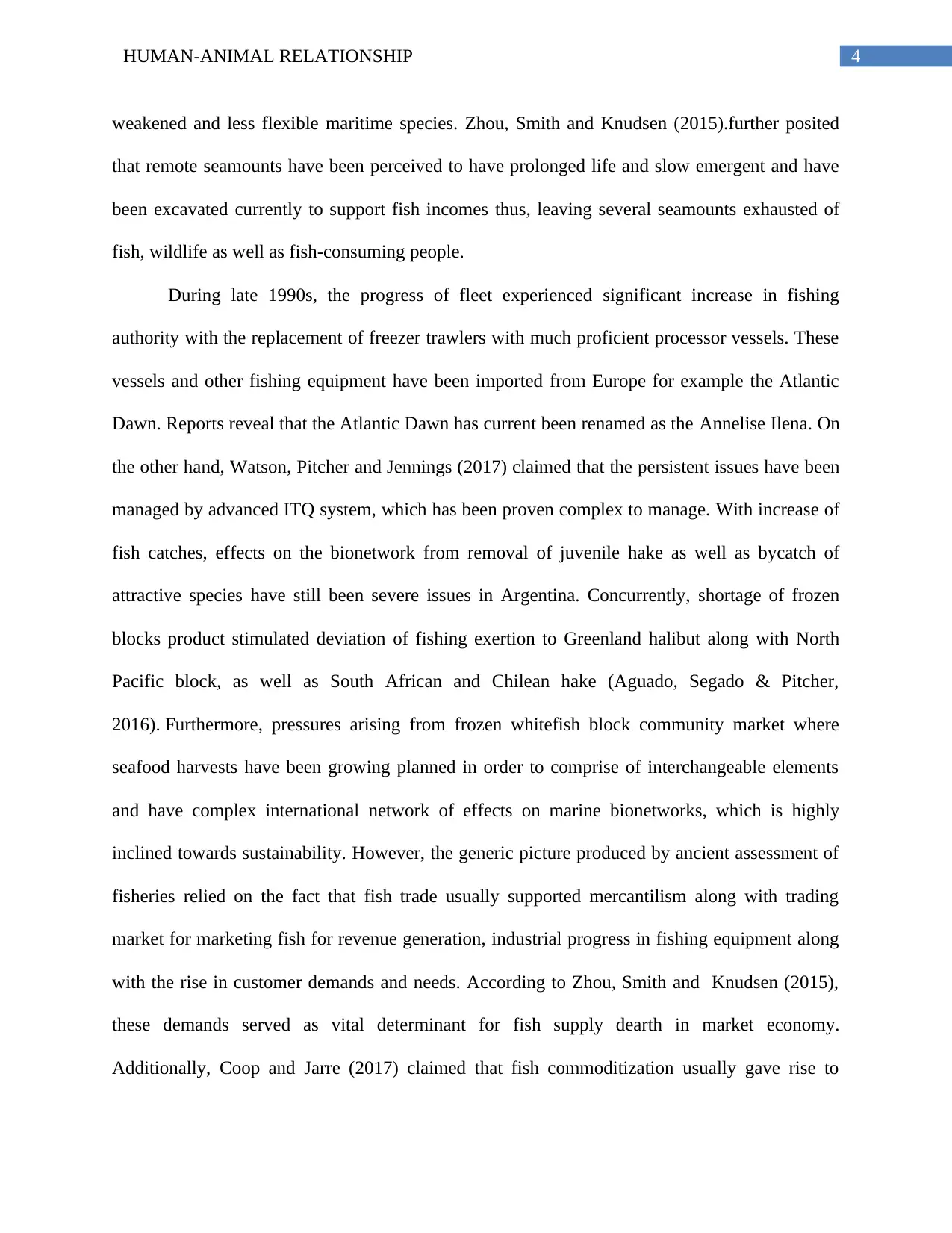
4HUMAN-ANIMAL RELATIONSHIP
weakened and less flexible maritime species. Zhou, Smith and Knudsen (2015).further posited
that remote seamounts have been perceived to have prolonged life and slow emergent and have
been excavated currently to support fish incomes thus, leaving several seamounts exhausted of
fish, wildlife as well as fish-consuming people.
During late 1990s, the progress of fleet experienced significant increase in fishing
authority with the replacement of freezer trawlers with much proficient processor vessels. These
vessels and other fishing equipment have been imported from Europe for example the Atlantic
Dawn. Reports reveal that the Atlantic Dawn has current been renamed as the Annelise Ilena. On
the other hand, Watson, Pitcher and Jennings (2017) claimed that the persistent issues have been
managed by advanced ITQ system, which has been proven complex to manage. With increase of
fish catches, effects on the bionetwork from removal of juvenile hake as well as bycatch of
attractive species have still been severe issues in Argentina. Concurrently, shortage of frozen
blocks product stimulated deviation of fishing exertion to Greenland halibut along with North
Pacific block, as well as South African and Chilean hake (Aguado, Segado & Pitcher,
2016). Furthermore, pressures arising from frozen whitefish block community market where
seafood harvests have been growing planned in order to comprise of interchangeable elements
and have complex international network of effects on marine bionetworks, which is highly
inclined towards sustainability. However, the generic picture produced by ancient assessment of
fisheries relied on the fact that fish trade usually supported mercantilism along with trading
market for marketing fish for revenue generation, industrial progress in fishing equipment along
with the rise in customer demands and needs. According to Zhou, Smith and Knudsen (2015),
these demands served as vital determinant for fish supply dearth in market economy.
Additionally, Coop and Jarre (2017) claimed that fish commoditization usually gave rise to
weakened and less flexible maritime species. Zhou, Smith and Knudsen (2015).further posited
that remote seamounts have been perceived to have prolonged life and slow emergent and have
been excavated currently to support fish incomes thus, leaving several seamounts exhausted of
fish, wildlife as well as fish-consuming people.
During late 1990s, the progress of fleet experienced significant increase in fishing
authority with the replacement of freezer trawlers with much proficient processor vessels. These
vessels and other fishing equipment have been imported from Europe for example the Atlantic
Dawn. Reports reveal that the Atlantic Dawn has current been renamed as the Annelise Ilena. On
the other hand, Watson, Pitcher and Jennings (2017) claimed that the persistent issues have been
managed by advanced ITQ system, which has been proven complex to manage. With increase of
fish catches, effects on the bionetwork from removal of juvenile hake as well as bycatch of
attractive species have still been severe issues in Argentina. Concurrently, shortage of frozen
blocks product stimulated deviation of fishing exertion to Greenland halibut along with North
Pacific block, as well as South African and Chilean hake (Aguado, Segado & Pitcher,
2016). Furthermore, pressures arising from frozen whitefish block community market where
seafood harvests have been growing planned in order to comprise of interchangeable elements
and have complex international network of effects on marine bionetworks, which is highly
inclined towards sustainability. However, the generic picture produced by ancient assessment of
fisheries relied on the fact that fish trade usually supported mercantilism along with trading
market for marketing fish for revenue generation, industrial progress in fishing equipment along
with the rise in customer demands and needs. According to Zhou, Smith and Knudsen (2015),
these demands served as vital determinant for fish supply dearth in market economy.
Additionally, Coop and Jarre (2017) claimed that fish commoditization usually gave rise to
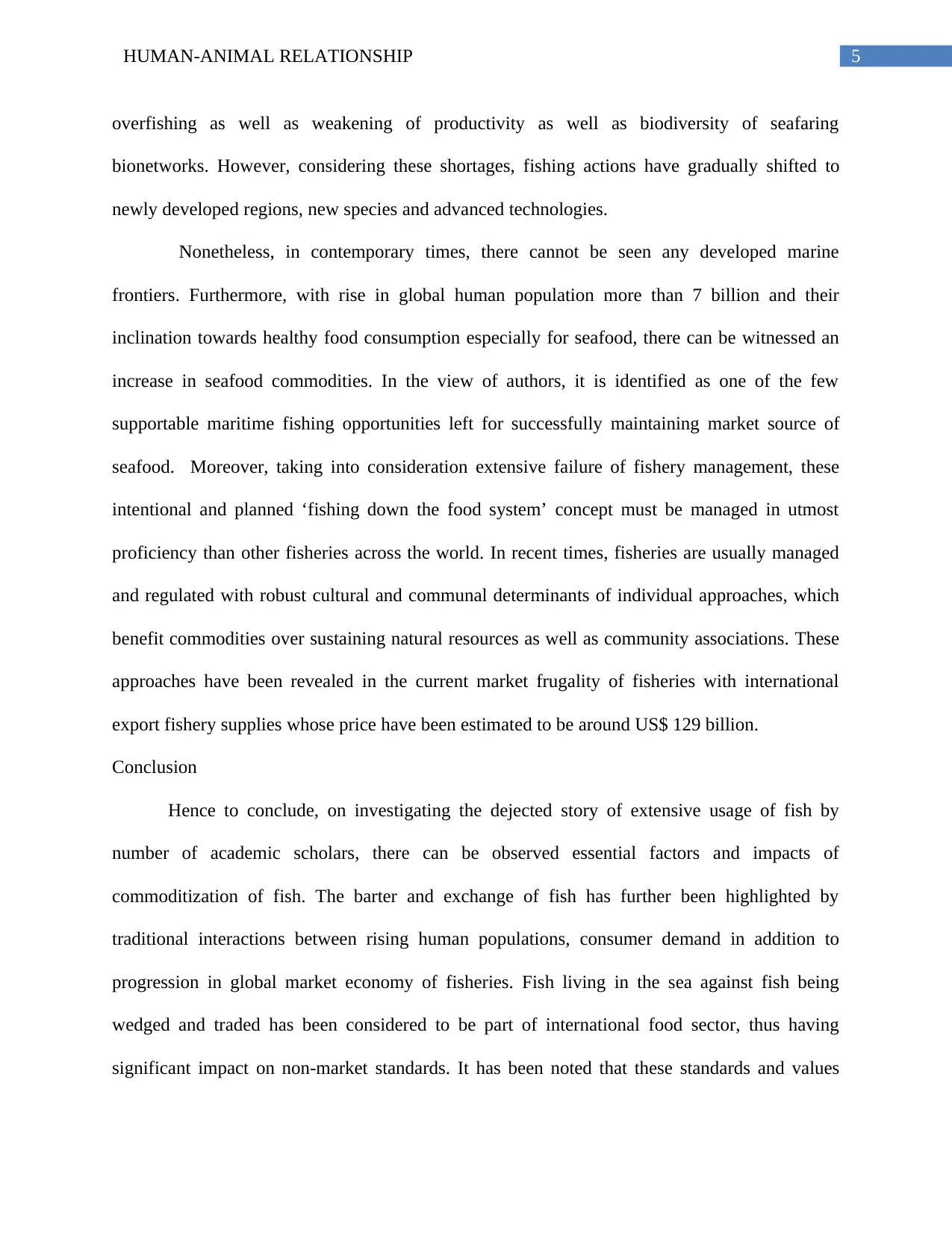
5HUMAN-ANIMAL RELATIONSHIP
overfishing as well as weakening of productivity as well as biodiversity of seafaring
bionetworks. However, considering these shortages, fishing actions have gradually shifted to
newly developed regions, new species and advanced technologies.
Nonetheless, in contemporary times, there cannot be seen any developed marine
frontiers. Furthermore, with rise in global human population more than 7 billion and their
inclination towards healthy food consumption especially for seafood, there can be witnessed an
increase in seafood commodities. In the view of authors, it is identified as one of the few
supportable maritime fishing opportunities left for successfully maintaining market source of
seafood. Moreover, taking into consideration extensive failure of fishery management, these
intentional and planned ‘fishing down the food system’ concept must be managed in utmost
proficiency than other fisheries across the world. In recent times, fisheries are usually managed
and regulated with robust cultural and communal determinants of individual approaches, which
benefit commodities over sustaining natural resources as well as community associations. These
approaches have been revealed in the current market frugality of fisheries with international
export fishery supplies whose price have been estimated to be around US$ 129 billion.
Conclusion
Hence to conclude, on investigating the dejected story of extensive usage of fish by
number of academic scholars, there can be observed essential factors and impacts of
commoditization of fish. The barter and exchange of fish has further been highlighted by
traditional interactions between rising human populations, consumer demand in addition to
progression in global market economy of fisheries. Fish living in the sea against fish being
wedged and traded has been considered to be part of international food sector, thus having
significant impact on non-market standards. It has been noted that these standards and values
overfishing as well as weakening of productivity as well as biodiversity of seafaring
bionetworks. However, considering these shortages, fishing actions have gradually shifted to
newly developed regions, new species and advanced technologies.
Nonetheless, in contemporary times, there cannot be seen any developed marine
frontiers. Furthermore, with rise in global human population more than 7 billion and their
inclination towards healthy food consumption especially for seafood, there can be witnessed an
increase in seafood commodities. In the view of authors, it is identified as one of the few
supportable maritime fishing opportunities left for successfully maintaining market source of
seafood. Moreover, taking into consideration extensive failure of fishery management, these
intentional and planned ‘fishing down the food system’ concept must be managed in utmost
proficiency than other fisheries across the world. In recent times, fisheries are usually managed
and regulated with robust cultural and communal determinants of individual approaches, which
benefit commodities over sustaining natural resources as well as community associations. These
approaches have been revealed in the current market frugality of fisheries with international
export fishery supplies whose price have been estimated to be around US$ 129 billion.
Conclusion
Hence to conclude, on investigating the dejected story of extensive usage of fish by
number of academic scholars, there can be observed essential factors and impacts of
commoditization of fish. The barter and exchange of fish has further been highlighted by
traditional interactions between rising human populations, consumer demand in addition to
progression in global market economy of fisheries. Fish living in the sea against fish being
wedged and traded has been considered to be part of international food sector, thus having
significant impact on non-market standards. It has been noted that these standards and values
⊘ This is a preview!⊘
Do you want full access?
Subscribe today to unlock all pages.

Trusted by 1+ million students worldwide
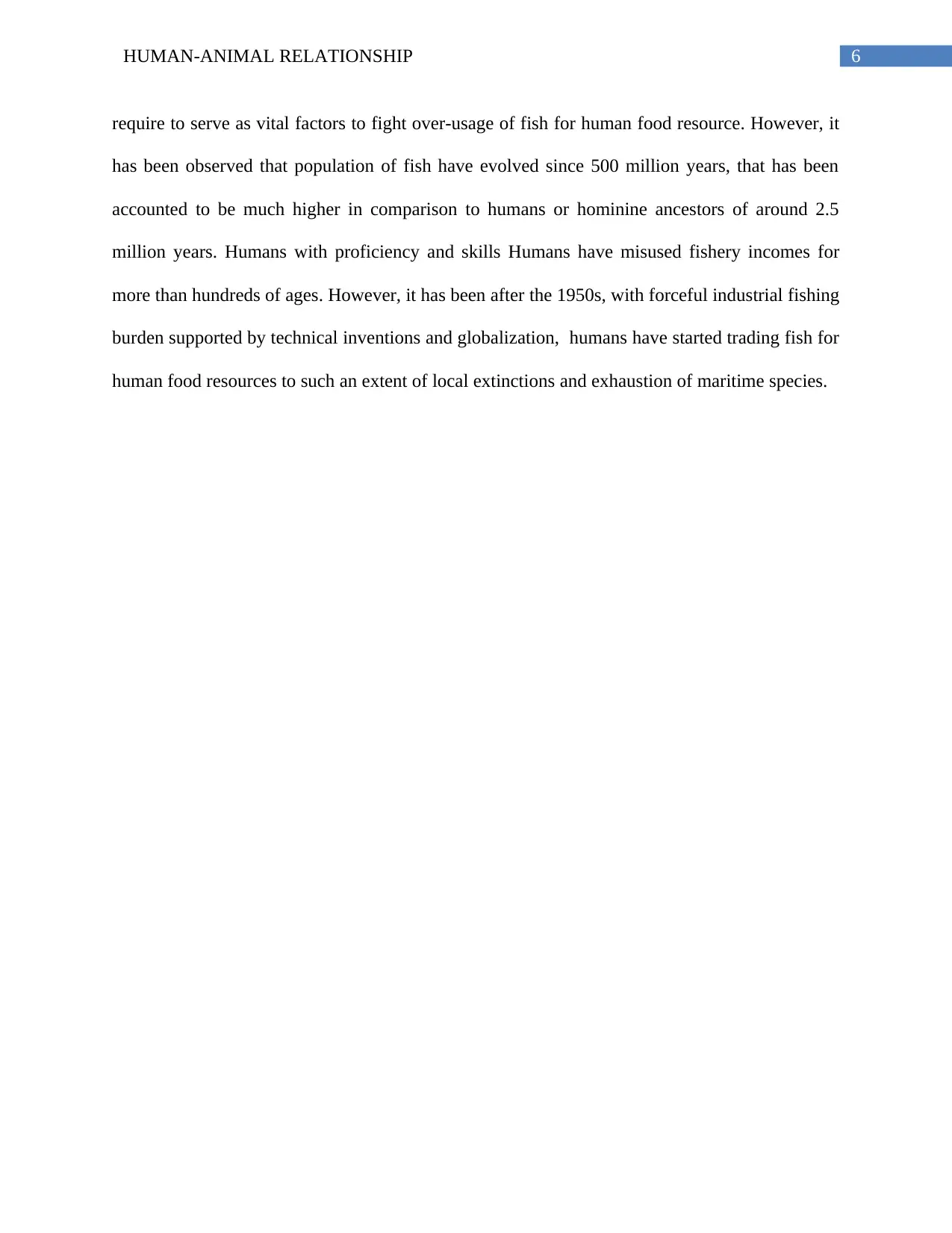
6HUMAN-ANIMAL RELATIONSHIP
require to serve as vital factors to fight over-usage of fish for human food resource. However, it
has been observed that population of fish have evolved since 500 million years, that has been
accounted to be much higher in comparison to humans or hominine ancestors of around 2.5
million years. Humans with proficiency and skills Humans have misused fishery incomes for
more than hundreds of ages. However, it has been after the 1950s, with forceful industrial fishing
burden supported by technical inventions and globalization, humans have started trading fish for
human food resources to such an extent of local extinctions and exhaustion of maritime species.
require to serve as vital factors to fight over-usage of fish for human food resource. However, it
has been observed that population of fish have evolved since 500 million years, that has been
accounted to be much higher in comparison to humans or hominine ancestors of around 2.5
million years. Humans with proficiency and skills Humans have misused fishery incomes for
more than hundreds of ages. However, it has been after the 1950s, with forceful industrial fishing
burden supported by technical inventions and globalization, humans have started trading fish for
human food resources to such an extent of local extinctions and exhaustion of maritime species.
Paraphrase This Document
Need a fresh take? Get an instant paraphrase of this document with our AI Paraphraser
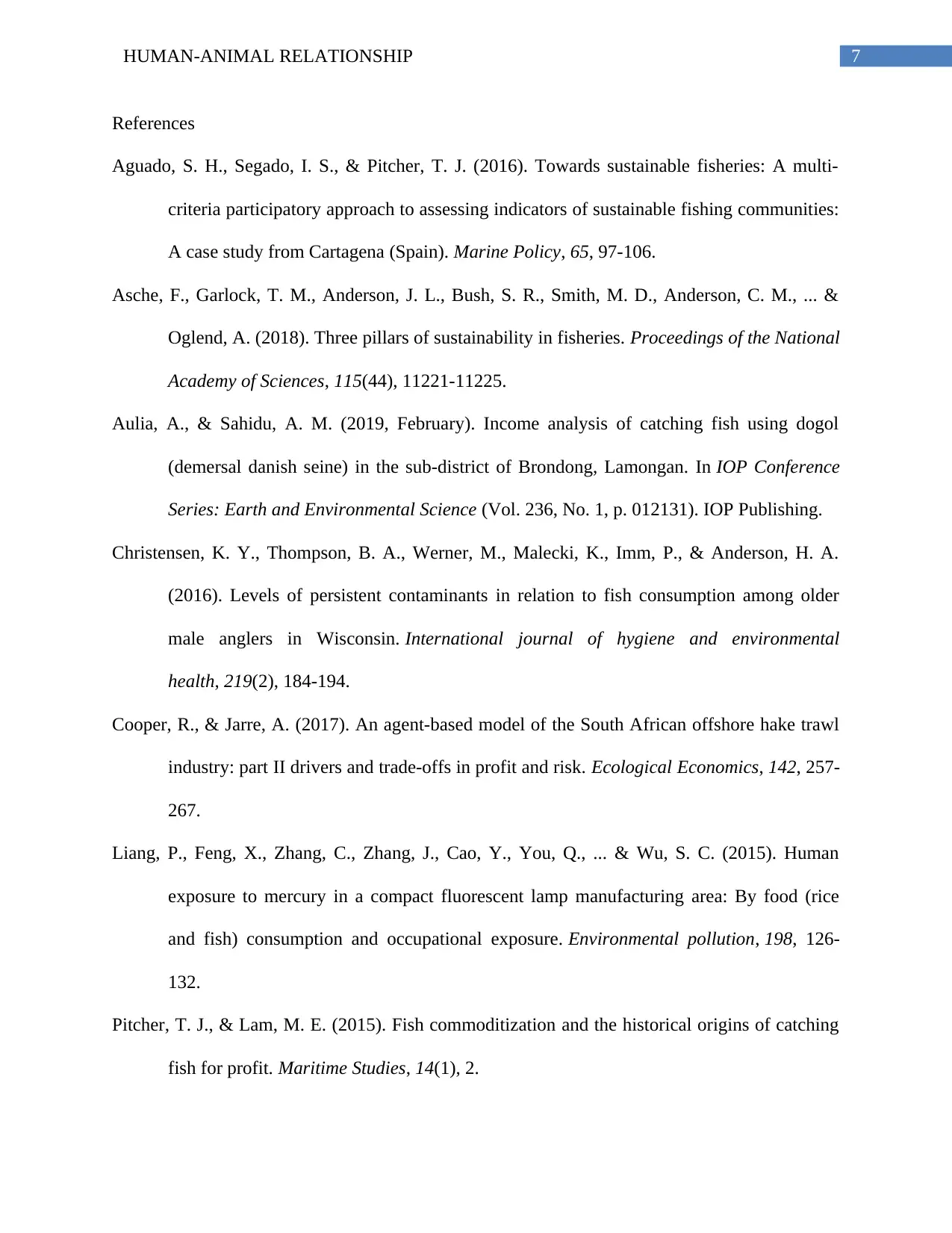
7HUMAN-ANIMAL RELATIONSHIP
References
Aguado, S. H., Segado, I. S., & Pitcher, T. J. (2016). Towards sustainable fisheries: A multi-
criteria participatory approach to assessing indicators of sustainable fishing communities:
A case study from Cartagena (Spain). Marine Policy, 65, 97-106.
Asche, F., Garlock, T. M., Anderson, J. L., Bush, S. R., Smith, M. D., Anderson, C. M., ... &
Oglend, A. (2018). Three pillars of sustainability in fisheries. Proceedings of the National
Academy of Sciences, 115(44), 11221-11225.
Aulia, A., & Sahidu, A. M. (2019, February). Income analysis of catching fish using dogol
(demersal danish seine) in the sub-district of Brondong, Lamongan. In IOP Conference
Series: Earth and Environmental Science (Vol. 236, No. 1, p. 012131). IOP Publishing.
Christensen, K. Y., Thompson, B. A., Werner, M., Malecki, K., Imm, P., & Anderson, H. A.
(2016). Levels of persistent contaminants in relation to fish consumption among older
male anglers in Wisconsin. International journal of hygiene and environmental
health, 219(2), 184-194.
Cooper, R., & Jarre, A. (2017). An agent-based model of the South African offshore hake trawl
industry: part II drivers and trade-offs in profit and risk. Ecological Economics, 142, 257-
267.
Liang, P., Feng, X., Zhang, C., Zhang, J., Cao, Y., You, Q., ... & Wu, S. C. (2015). Human
exposure to mercury in a compact fluorescent lamp manufacturing area: By food (rice
and fish) consumption and occupational exposure. Environmental pollution, 198, 126-
132.
Pitcher, T. J., & Lam, M. E. (2015). Fish commoditization and the historical origins of catching
fish for profit. Maritime Studies, 14(1), 2.
References
Aguado, S. H., Segado, I. S., & Pitcher, T. J. (2016). Towards sustainable fisheries: A multi-
criteria participatory approach to assessing indicators of sustainable fishing communities:
A case study from Cartagena (Spain). Marine Policy, 65, 97-106.
Asche, F., Garlock, T. M., Anderson, J. L., Bush, S. R., Smith, M. D., Anderson, C. M., ... &
Oglend, A. (2018). Three pillars of sustainability in fisheries. Proceedings of the National
Academy of Sciences, 115(44), 11221-11225.
Aulia, A., & Sahidu, A. M. (2019, February). Income analysis of catching fish using dogol
(demersal danish seine) in the sub-district of Brondong, Lamongan. In IOP Conference
Series: Earth and Environmental Science (Vol. 236, No. 1, p. 012131). IOP Publishing.
Christensen, K. Y., Thompson, B. A., Werner, M., Malecki, K., Imm, P., & Anderson, H. A.
(2016). Levels of persistent contaminants in relation to fish consumption among older
male anglers in Wisconsin. International journal of hygiene and environmental
health, 219(2), 184-194.
Cooper, R., & Jarre, A. (2017). An agent-based model of the South African offshore hake trawl
industry: part II drivers and trade-offs in profit and risk. Ecological Economics, 142, 257-
267.
Liang, P., Feng, X., Zhang, C., Zhang, J., Cao, Y., You, Q., ... & Wu, S. C. (2015). Human
exposure to mercury in a compact fluorescent lamp manufacturing area: By food (rice
and fish) consumption and occupational exposure. Environmental pollution, 198, 126-
132.
Pitcher, T. J., & Lam, M. E. (2015). Fish commoditization and the historical origins of catching
fish for profit. Maritime Studies, 14(1), 2.

8HUMAN-ANIMAL RELATIONSHIP
Röcklinsberg, H. (2015). Fish consumption: choices in the intersection of public concern, fish
welfare, food security, human health and climate change. Journal of Agricultural and
Environmental Ethics, 28(3), 533-551.
Song, A. M., Scholtens, J., Stephen, J., Bavinck, M., & Chuenpagdee, R. (2017). Transboundary
research in fisheries. Marine Policy, 76, 8-18.
Watson, R. A., & Tidd, A. (2018). Mapping nearly a century and a half of global marine fishing:
1869–2015. Marine Policy, 93, 171-177.
Watson, R. A., Pitcher, T. J., & Jennings, S. (2017). Plenty more fish in the sea?. Fish and
fisheries, 18(1), 105-113.
Zhou, S., Smith, A. D., & Knudsen, E. E. (2015). Ending overfishing while catching more
fish. Fish and Fisheries, 16(4), 716-722.
Röcklinsberg, H. (2015). Fish consumption: choices in the intersection of public concern, fish
welfare, food security, human health and climate change. Journal of Agricultural and
Environmental Ethics, 28(3), 533-551.
Song, A. M., Scholtens, J., Stephen, J., Bavinck, M., & Chuenpagdee, R. (2017). Transboundary
research in fisheries. Marine Policy, 76, 8-18.
Watson, R. A., & Tidd, A. (2018). Mapping nearly a century and a half of global marine fishing:
1869–2015. Marine Policy, 93, 171-177.
Watson, R. A., Pitcher, T. J., & Jennings, S. (2017). Plenty more fish in the sea?. Fish and
fisheries, 18(1), 105-113.
Zhou, S., Smith, A. D., & Knudsen, E. E. (2015). Ending overfishing while catching more
fish. Fish and Fisheries, 16(4), 716-722.
⊘ This is a preview!⊘
Do you want full access?
Subscribe today to unlock all pages.

Trusted by 1+ million students worldwide
1 out of 9
Your All-in-One AI-Powered Toolkit for Academic Success.
+13062052269
info@desklib.com
Available 24*7 on WhatsApp / Email
![[object Object]](/_next/static/media/star-bottom.7253800d.svg)
Unlock your academic potential
Copyright © 2020–2025 A2Z Services. All Rights Reserved. Developed and managed by ZUCOL.
